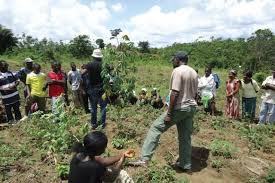This article continues the focus on leadership in rural communities. The objectives below specify what is expected to be understood after studying this article.
Read Also: 18 Medicinal Health Benefits Of Maidenhair Tree (Ginkgo Biloba)
Leaders’ Bases Of Power And Influence in Rural Communities

That leadership involves the ability to influence, direct or control others means that leadership involves the use of power. The leader must have a recognized power, the source of which may be within or outside the group led.
When power is from the group, it is spontaneously accorded by followers, whereas when the source of power is located externally, there may be some elements of coercion. Power is the ability to exact compliance or the ability to execute one’s will irrespective of opposition.
Cartwright and Zander (1960) identified five bases of power of a group leader. These include:
1. Reward power which derives from the belief on the part of the followers that they will be rewarded in some way for complying;
2. Coercive power which arises from the belief that non-compliance will result in punishment;
3. Expert power when a person is evaluated to have needed knowledge, information or skills which cannot be obtained readily elsewhere, that person holds power over the group;
4. Referent power is the power the leader has as a result of having qualities which group members like, admire and want to identify with; they submit because they identify with the leader;
5. Legitimate power derives from the office or official position which the individual occupies and gives the right to control others and compels compliance. The tax collector and the police all have legitimate powers to do their work.
Power is usually conceived in terms of authority and of influence. Authority and influence are not synonymous. An individual who has influence may not have any authority.
Authority derives from official position and is the power attached to that office, whereas influence resides within the individual based on possession of certain characteristics or qualities which make others submit. Moss (1970), in a study of community leaders, identified six bases of influence. These include the following:
1. Official Position: This may be elected, appointed or earned office within the political structure. The village headship is an official position, for instance. It grants the incumbent a minimum of functions and responsibilities, enabling involvement in and influence over community issues more readily than others. It provides access to knowledge, popularity, skills, and legitimates influence.
2. Financial Control: Economic base such as control over money, credit, jobs and essential services is a strong basis of influence. Wealthy individuals may increase influence by donating generously to community programmes. In many parts of Nigeria, traditional titles may be purchased, integrating such individuals into the community power structure.
3. Organizational Influence: This is derived from the ability to mobilize and organize others into active groups and participation in organizations. Community issues are often handled through formal and informal organizations, making active members influential.
4. Knowledge or Expertness: Related to official position but distinct, it involves having particular knowledge or skills above others in the group.
5. Interpersonal Contacts: This includes access to and interaction with others both within and outside the community. Individuals with many friends and contacts are likely to be more informed and influential. Community members may depend on such individuals for connections to external agencies.
6. Personal Characteristics: Includes attributes such as personality, popularity, charisma, honesty, and eloquence. These traits alone may not guarantee influence but become effective when combined with other bases of influence.
Read Also: 19 Medicinal Health Benefits Of Avens (Geum)
Functions of Leaders in Agricultural Communities

To advance the powers of a group, leaders must perform certain functions. In any social situation, four fundamental leadership functions include goal-setting, goal-achievement, group maintenance, and group evaluation and feedback. Acts of leadership should result in satisfactory performance of these functions for group existence to be justified.
Rose and Hendry (1957) identified nine interrelated leadership functions:
1. Viscidity: The tendency of the group to pull together. It reflects how well members work as a unit. The leader facilitates viscidity by minimizing conflicts and promoting unity.
2. Hedonic Tone: The degree of agreeableness among group members, including group atmosphere, relationships, and satisfaction. The leader enhances this tone by fostering positive experiences and interactions.
3. Syntality: The expected performance of the group in a given situation. It includes integration, morale, sociability, and cohesiveness.
4. Goal Achievement: The extent to which group aims are attained. The leader helps define, mobilize resources, and achieve goals.
5. Initiative: The leader takes the lead in starting ideas, projects, discussions, and tasks.
6. Group and Goal Analysis: The leader analyzes group problems and processes to enhance productivity.
7. Communication: The leader ensures effective communication. When members are uninformed, interest declines.
8. Establishing Structure: After setting goals, the leader organizes roles and responsibilities for clarity and coordination.
9. Implementing Philosophy: The leader must align personal goals with group goals. Success depends on subordinating personal ambitions to those of the group.
Do you have any questions, suggestions, or contributions? If so, please feel free to use the comment box below to share your thoughts. We also encourage you to kindly share this information with others who might benefit from it. Since we can’t reach everyone at once, we truly appreciate your help in spreading the word. Thank you so much for your support and for sharing!

